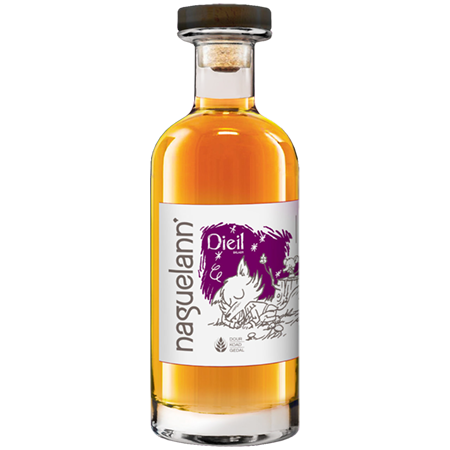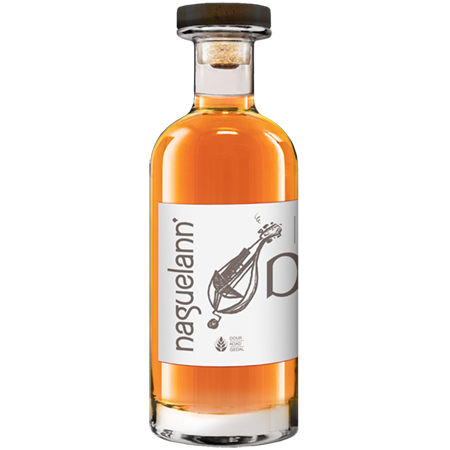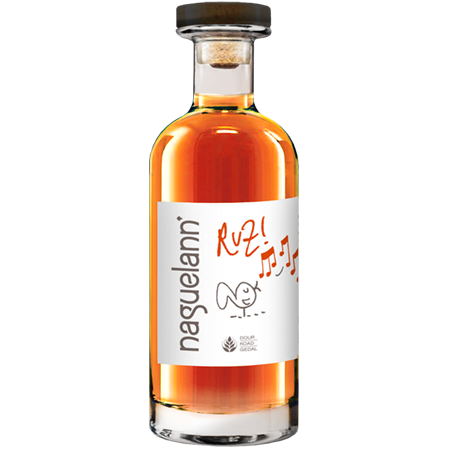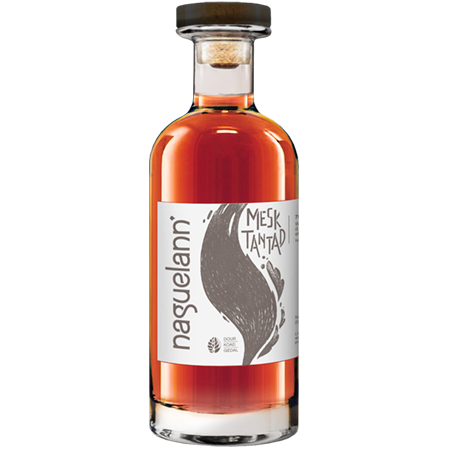Naguelann Distillerie
Brittany
Naguelann whiskies capture the Celtic spirit of maritime Brittany, and the creative vision of its founder Lénaïck Lemaitre.
Founded in 2014 near Saint-Malo, Naguelann (the name a playful tribute to Lénaîck’s hometown of Laguenan) is directly inspired by both Scotch techniques and the terroir of Brittany, defined both by its land and its people. These world class whiskies are a story of friendship, of reclaiming that which has been lost, and of a clear-eyed vision of the future.
France is a land with a passion for whisky. It had been the largest consumer of Scotch by volume until 2023, when it was dethroned by much more populous India. But aside from an appreciation for imported spirit, France has had a homegrown whisky renaissance of its own, with over a hundred whisky distilleries sprouting up in only the last thirty or so years. The wellspring of this movement is Brittany, which The Whisky Exchange calls “the spiritual core” of French whisky. Brittany, or Bretagne, is a region coterminous with the Armorican peninsula in the northwest of France, directly across the English channel from Cornwall. Considered one of the six historic Celtic nations (alongside Scotland, Ireland, the Isle of Man, Cornwall, and Wales), Brittany has a completely distinct heritage from the rest of modern France, with an indigenous language, specific local foodways, music, dance, and art.
In many ways, Whisky Breton was inevitable. Its cool, maritime climate, rich Celtic culture, and high-quality agriculture are a perfect recipe for top tier, Scotch-style whisky. It was only a matter of time. It was no surprise, then, that the first French whisky was produced by Waringham distillery in Lannion on the northern coast of Brittany. Since their first whisky release in 1987, and the subsequent launch of Armorik single malt in 1998, Whisky Breton has become one of only two IGP designations for whisky in France: IGP Whisky de Bretagne, and IGP Whisky d’Alsace. While Alsace has fairly strict parameters for their whisky, Brittany has chartered broader, more creatively-permissive guidelines of production. Whisky Breton can incorporate a variety of still types, cask finishes, and grains—including the area’s signature sarrasin, or buckwheat (eddu in Breton), which has been key to regional delicacies like galettes and Gâteau Breton.
Lénaïck Lemaitre never planned on operating a distillery. Even when he launched the Naguelann brand, his narrow focus was on the practice of aging and blending whisky. Lénaïck is experienced in these realms, and was actually the first whisky blender in Brittany. He owns a bottle shop and tasting room in picturesque Saint-Malo, and founded private scotch label The Celtic Guy, allowing him to purchase, age, and blend bespoke Scotch bottlings for the French market. When launching Naguelann, Lénaïck began first by aging local distillates from his friends, including buckwheat distillate made nearby by Distillerie des Menhirs. It was a convivial endeavor, with Lénaïck’s background as a bartender influencing his collaborations. In fact, it was this skill that first led him to a passion for whisky, when he won a trip with a small cohort of French bartenders to tour distilleries in Scotland. It was this trip that cemented his devotion to whisky, first as a blender, cellarer, and bottler—and eventually, distiller.
After a few years of aging and blending his friends’ whiskies, Lénaïck became eager to tell a deeper story of Breton whisky. He bought a small copper pot still—a petite 500L—from German manufacturer Unicobres, and installed it in the tiny, rustic room that is now the main stillhouse. The distillery and his office actually occupies his neighbor’s former home, with his parents still living right over the fence in his childhood home. This neighbor’s grandfather was known for making some of the best traditional cider in the area, and this love of beverage was infectious, even to a young Lénaïck next door. The distillery is an homage to this tradition, and it was built with the family’s blessing. Lénaïck describes the distillery as built like a boat, with every single inch used to maximum efficiency. In fact, when he squeezed in three additional 1000L alembics to accompany his original still, he had to take out parts of the ceiling plank by plank to allow for their height.
Nagelann’s mantra is Dour, Koad, Gedal—Breton for ‘Water, Wood, Time’.
These three elements speak directly to the origins and intent of the project, as Lénaïck approaches each spirit more like a patient artist than a distiller; this perspective is unavoidable for him. The multifaceted Lénaïck is a composer, pianist, and marathoner, though his roots are much more rustic. Lénaïck grew up with a chef father, and the inherited understanding of the tension between fixed recipe and intuition formed the core of his whisky-blending ethos. Walking into the barrel house, a small dunnage room with sunlight streaming through the partly open roof, Lénaïck quips “welcome to the kitchen.” There are no cask finishes at Naguelann—every whisky is distilled with a specific vision, with new make alcohol going immediately into their intended casks, from old French oak, to St-Émilion red wine casks, to ex-Islay whisky casks. “I only have recipes,” Lénaïck explains. “There is no ‘single-malt-plus-cask-finish.’ It’s not cask finishing, it’s cask starting.” This technique flips the Scotch aging style on its head, and takes an incredible amount of courage. Rather than starting his whisky in ex-Bourbon or neutral oak barrels and then adding a dash of personality at the conclusion, Lénaïck forges his own path by deciding the direction of each of the whiskies at inception and carefully guiding its individual path through his cellar.
These barrels are a motley crew of varying oak, wine, and whisky origins. While he sources classic barrels of old and new French oak, Lénaïck also uses first-fill, ex-St-Émilion Bordeaux casks as well as a variety of ex-Scotch casks. This includes very old barrels from Ben Nevis, ex-Islay casks from Caol Ila, and various others from the likes of Tullibardine and Glenrothes. Most of these barrels are left in their original 60L sizes, but Lénaïck also works with two coopers in Brittany to resize some of these barrels into smaller, quarter-cask formats. Directly inspired by Laphroiag’s use of quarter casks, the smaller barrels offer a far more intense extraction of flavor than a larger barrel (due to an increased proportion of direct liquid-on-wood contact). And when factoring in the personality imparted by, say, an ex-St-Émilion red wine cask, the effect is amplified even more so than with a new or neutral oak quarter cask.
Once carefully aged, blended, and rested, every Naguelann whisky is minimally filtered by gravity before bottling, using merely a cheese cloth to filter out particulate. This light touch can occasionally leave a touch of cloudiness in the whisky, which speaks to its authenticity and depth of flavor. Naguelann is downproofed with Brittany’s prized natural mineral water, Plancoët, showing the heart of the whisky like a prism amplifying the full colors of a ray of light.
Naguelann’s naming scheme uses “Dieil” in place of single malt, “Tantad” instead of peated, and “Mesk” for a blend. The insistence on Breton terms is critical for Lénaïck. This Celtic language was banned in public schools for almost one hundred years, lifted only in 1951, leaving generations separated from their mother tongue. Once feared on the path toward extinction, it is now undergoing a revival, concurrent with a resurgent sense of pride in Breton identity. Lénaïck himself has begun studying his heritage language, and his use of it at Naguelann—in the whiskies, in the signage, in the ethos—reflects its deep roots embedded in Brittany’s culture.
The first US release of Naguelann whiskies centers around a trio of single malts, the Dieil series, each carefully aged three-to-six years in a sequence of different types of barrel (ex-red wine, ex-Islay whisky, freshly charred barrels, very old French oak barrels), where the varied wood influence presents like decisively applied splashes of color on a canvas of ocean-tinged, peated whisky. These three are accompanied by a single malt whisky called Ruz! (red in Breton), aged start-to-finish in ex-St-Émilion Bordeaux casks; and a blended whisky of unpeated barley, peated barley and local buckwheat called Mesk Tantad (mix and burnt in Breton, respectively).
In 2023, to celebrate the upcoming 10th year of Naguelann, Lénaïck embarked on an ambitious commemoration project. During a post-pandemic sabbatical in Saint-Jacut-de-la-Mer, he composed an entire piano album, re-engaging a passion that had to be de-emphasized while he built the distillery. That album (available for listening here, and on your app of choice) is an audio accompaniment for his whisky range, and like the whiskies themselves, is serious, nuanced, heartfelt, and genuine—and very good. But Lénaïck also has a way of dodging pretension in his pursuits, a trait reflected in his collaboration with local and French illustrators and cartoonists on special boxes and labels for the anniversary edition of Naguelann. Their custom artwork helps define the specific contents of the bottlings, as well as reinforcing the lighthearted Celtic character of the whole enterprise. We’re delighted that this packaging will be featured on every bottle of Naguelann that De Maison brings to the US.
Naguelann is driven by the terroir of culture—not by individual plots of land, but by the specific history and artistry of a place and its people. It digs deep into the Celtic roots of the Brittany region, applying Scotch techniques with absolute precision, delivering something as personal as a fingerprint. It takes a visionary like Lénaïck to create spirits like these whiskies, so specific to their region and their maker. Through this amalgamation of culture and land and history and heart, the whisky speaks loudly and clearly for itself, in crystal-clear Breton.





